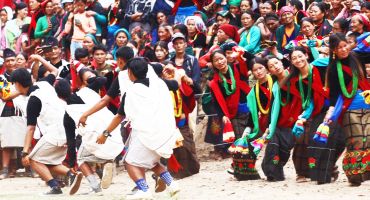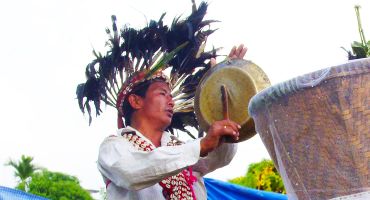In a Tamang society , a Tamba is a traditional historian, oral narrator, genealogist, minstrel, singer, storyteller, and expert in rituals. Tambas are the living memory of their community and repositories of rich oral traditions who can act as windows into the cultural worldview of the Tamang people. The knowledge of Tambas itself is organized, stored, and communicated in narrative-based prose-poem songs known as Hwai. These traditional narrative songs are sung during various life-cycle rituals. Knowledge, traditions, ritual practices, and collective communal memory are embedded within these narrative songs and stories which are shared and communicated through their re-telling.
“A Tamba seems to be above all an advisor and commentator on rituals.” – W. Alexander
In a group of seven elders within a Tamang tribe, Tambas always hold a prominent place. These elders who make important decisions within the tribe are:
1. Choho – The Headman
2. Mulumi – The Leader of the Village
3. Tamba – Ritual Expert and Historian
4. Dopta – The Wise
5. Ngapta – The Resourceful
6. Ganba – Village Elder
7. Mulumi Gaurai – The Headman’s apprentice
These elders mediate differences between individuals within the community and use their experience and knowledge of traditional customs. Tambas, with their vast knowledge of culture, traditions, and rituals, provide a sociocultural and historical account of the community and become the voice of traditions within the tribe. Tamba oral tradition is a unique aspect of Tamang culture and has managed to preserve Tamang rituals, history, mythology, music, language, and identity in the purest form. Tamang Tambas are orators, minstrels, storytellers, and their narrative is always sung or spoken in the Tamang language. Tam means speech and, Ba is a person or upholder.
Within the social fabric of the Tamang community, a Tamba is also a village or social elder or a leader and holds prominence due to his knowledge of culture and traditions. During marriage rituals, because of his knowledge of genealogies, a Tamba takes center stage. During marriage ceremonies, he puts across riddles to other Tambas and answers those put across to him. The wedding Hwai which constitutes 76 lines talks about Tamang history, traditions, and genealogies.

Traditional discourse is very much a part of Tamang ritual practices. This regularly leads the Tambas to interact with each other through songs. ‘The groom’s side opens the proceedings by demanding, ‘You must tell us how the name of Tamang came about and how our ancestors brought us from Tibet.’ The Tamba goes on to recount the journey from Tibet via Jharlang and Setang (Timure) under the leadership of Lhake Dorje and how he gave the names to the 18 clans and said which could intermarry.’ – Andrew Rotley Hall, (Religion in Tamang Society)
Oral traditions, as the transmission of cultural items from one generation to the next, are heard, collected in memory, and recalled at the moment of customary rites. The Himalayan tribes have used the form of legends, myths, poems, stories, and folklores to preserve their ideas, values, and philosophy. Thus, a Tamba imparts a community’s values through his songs. He sings before the bride and the groom and tells them about the responsibilities and duties within a marital relationship. As a master of ceremonies, his presence is required during various rituals such as a “Pasni” or “Chhewar.” But apart from these roles and functions that a Tamba enacts and embodies, he is also a bard or a minstrel who has carried on the oral tradition of the Tamang people throughout the centuries.
In Tamang traditions, there are three types of officiants. There is a Lama who is a Buddhist monk, a Bonbo who is a Tamang Shaman and the third is a Tamba. The Tamba always acknowledges the presence of the Elders, the Monk, and the Shaman before he begins his historical narrative.
Tamba narrative begins with:
“Here, as a witness, stand knowledgeable and the wise. Radiant like the moon and the sun, they are all gathered here. Blessed by Lord Dewa Sangey, Maawang Sangey, Dawa Sangey, and all the gods in the high heavens, the Lama, who knows the wisdom of the three worlds, also sits upon his Thi (throne) among us. To the Shaman who knows the magic of the plains and the hills, the mountains and all the elders present here, I offer my respects.” –Santbir Lama (Tamba Kaiten Whai Rimathim)

Tambas sing the Tamba La Hwai, which are Tamang songs that talk about Tamang myths, traditions, beliefs, philosophy, and rituals. Traditionally Hwai were ritualistic songs and held tremendous importance in Tamang rituals. Tambas who know their Hwai are requested by the respective family to oversee the rituals. They are to be requested in a small ceremony where offerings are placed and sacred juniper is kindled to initiate Hwai singing. Today, Tambas are viewed as a reclamation of culture, an honoring of their ancestors, and symbols of a rich Tamang cultural heritage. It is this same Tamba la Hwai melody that became so popular that it permeated into mainstream Nepali culture and went on the become the Tamang Selo.
A Tamba usually has an apprentice to whom all knowledge will be passed on. It is practical performance and rigorous practice that gives the apprentice the status of a Tamba. Due to the oral nature of the knowledge system, the apprentice of a Tamba learns his craft by following the way of his master. He learns by listening and observing, and practicing. The student Tambas will someday represent the inherent social, traditional, and symbolic structure of the tribe.
It is through the telling of stories and legends that Tambas preserve what is most important to a community—language, traditions, and identity. Tamba oral tradition reinforces ritualistic imperatives and maps identity and social associations. They create a response to social needs and give members of a group a sense of belonging to a community by conveying shared values. For centuries, the Tamang people have retained oral tradition that is distinct from the literacy consciousness of their mainstream Himalayan neighbors because this unwritten manuscript belongs to all, and the Tamba must hold on to it for a while and pass it on. The oral narratives of the Tamba, its essence, much like an individual, can have abstruse contrasts and lengthy timelines but all fuse together to form a beautiful image of a Tamang worldview that ardently corresponds to their social and cultural values.





Leave a Reply